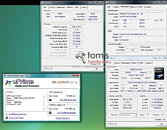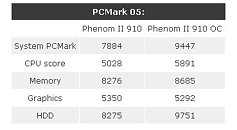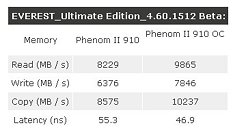- Joined
- Oct 9, 2007
- Messages
- 47,300 (7.52/day)
- Location
- Hyderabad, India
| System Name | RBMK-1000 |
|---|---|
| Processor | AMD Ryzen 7 5700G |
| Motherboard | ASUS ROG Strix B450-E Gaming |
| Cooling | DeepCool Gammax L240 V2 |
| Memory | 2x 8GB G.Skill Sniper X |
| Video Card(s) | Palit GeForce RTX 2080 SUPER GameRock |
| Storage | Western Digital Black NVMe 512GB |
| Display(s) | BenQ 1440p 60 Hz 27-inch |
| Case | Corsair Carbide 100R |
| Audio Device(s) | ASUS SupremeFX S1220A |
| Power Supply | Cooler Master MWE Gold 650W |
| Mouse | ASUS ROG Strix Impact |
| Keyboard | Gamdias Hermes E2 |
| Software | Windows 11 Pro |
Better late than never, AMD is embracing the DDR3 memory standard. Its newest desktop CPU socket, the AM3, connects the processor to dual-channel DDR3 memory. Initial specifications about AMD's processors on the new socket suggest that DDR3 1333MHz (PC3-10600) will be held as the memory standard the integrated memory controllers on AMD's processors support. The far-east team of Tom's Hardware posted the first series of benchmarks of a Phenom II AM3 processor, when paired with DDR3-1333. The benchmarks featured Gigabyte's MA790FXT-UD5P motherboard along with Corsair's dual-channel DDR3-1333 kit running at DRAM timings of 9-9-9-24. The CPU-Z window also shows that the memory modules are running unganged, meaning that the two memory controllers of the Deneb core are independent, with each controller handling a 64-bit wide memory channel. This state is somewhat comparable to that of single-channel memory, except that multi-threaded applications will still be able to independently address memory on each channel, utilizing all the bandwidth on offer.
At the center of the test-bench was the AMD Phenom II X4 910, the company's first flagship quad-core AM3 processor. The X4 910 features a default clock speed of 2.60 GHz. The same chip was tested in two settings: default clock-speeds, and overclocked to 3.12 GHz (240 x 13.0 @ default vCore). The screenshots below show the test results for WPrime. The overclocked chip scored a crunch-time of 46.613 s (1M). The overclock did not affect SuperPi at all, with insignificant differences in the scores between the two. PC Mark 05 got a decent boost, while 3DMark06 didn't. Memory bandwidth and latency tests showed something strange, with the overclocked CPU (in effect memory) turning up with lesser latency (while normally, increase in clock speeds tend to step up latencies). The tests show that there are increments in performance with the use of DDR3 memory, though they are merely proportional to the clock speeds the memory is running at.








View at TechPowerUp Main Site
At the center of the test-bench was the AMD Phenom II X4 910, the company's first flagship quad-core AM3 processor. The X4 910 features a default clock speed of 2.60 GHz. The same chip was tested in two settings: default clock-speeds, and overclocked to 3.12 GHz (240 x 13.0 @ default vCore). The screenshots below show the test results for WPrime. The overclocked chip scored a crunch-time of 46.613 s (1M). The overclock did not affect SuperPi at all, with insignificant differences in the scores between the two. PC Mark 05 got a decent boost, while 3DMark06 didn't. Memory bandwidth and latency tests showed something strange, with the overclocked CPU (in effect memory) turning up with lesser latency (while normally, increase in clock speeds tend to step up latencies). The tests show that there are increments in performance with the use of DDR3 memory, though they are merely proportional to the clock speeds the memory is running at.








View at TechPowerUp Main Site





